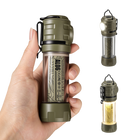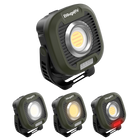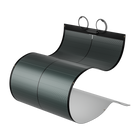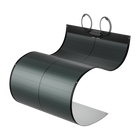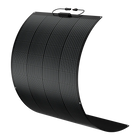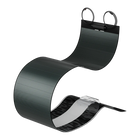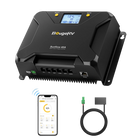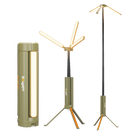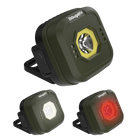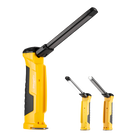Are Bifacial Solar Panels Worth It?


As the world increasingly turns towards renewable energy sources, solar technology continues to evolve, offering more efficient and innovative solutions. Among these advancements are bifacial solar panels, an innovative option that may revolutionize how we harness the sun's power.
With their ability to capture sunlight from both sides, these bifacial panels produce increased energy generation and potential cost savings over time. But are they truly worth the investment?
In this comprehensive guide, we'll explore the ins and outs of bifacial solar panels, what are they, their advantages and drawbacks, and help you determine whether they're the right choice for your energy needs.
Let’s jump into it!
What Is a Bifacial Solar Panel?

Bifacial solar panels can capture sunlight from both their front and back, unlike traditional monofacial panels that only absorb light on one side. The ability of bifacial solar panels to utilize reflected light increases their power generation potential by up to 30%.
Bifacial solar panels come in various styles and can perform optimally across different installation environments. They can be either framed or frameless. Some feature dual-glass construction, while others are made with transparent back sheets. Most bifacial solar panels use Monocrystalline cells, but there are also models with polycrystalline cells.
It's important to note that not all frameless, dual-glass modules are bifacial; the real bifacial panels have electrical contacts or busbars on the front and back of the solar cells.
When bifacial solar panels are installed on highly reflective surfaces, such as a white TPO roof or ground covered with pale-colored stones, they can even generate 30% more power from the rear. Set up vertically, bifacial solar panels can capture energy during two peak times: sunrise and sunset, and this flexibility enhances their performance.
Bifacial Solar Panel Efficiency

Bifacial solar panels boast efficiencies of 22–23% and excel in proper sun tracking systems. Properly installed in optimal conditions, bifacial solar panels can even produce up to 30% more electricity than monofacial panels.
The bifacial panels can also potentially work more efficiently in high temperatures thanks to their better heat dissipation. They’re exposed on both sides, which can result in a lower temperature coefficient and less efficiency loss with increased temperatures.
Bifacial Solar Panels Advantages and Disadvantages

Advantages of Bifacial Solar Panels
- Enhanced Energy Generation
Bifacial solar panels harness sunlight from both their front and back sides, which can lead to an increase of up to 30% in energy generation compared to standard panels.
The dual-sided design of bifacial solar panels is particularly beneficial in areas with high reflectivity, such as snowy environments or white rooftops, where reflected light can contribute to additional power generation.
- Versatile Installation Options
Bifacial solar panels are not limited to traditional rooftop installations. They can be mounted on the ground, integrated into carports, pergolas, gazebos, and awnings, and even be incorporated into building facades or used as sound barriers along highways.
- Work well at different angles
Bifacial solar panels can work at various orientations or angles as long as they face toward the equator. They can even be mounted vertically at 90° and still work excellently.
In large-scale commercial farm settings, bifacial solar panels are often raised above the ground, which allows natural light to reflect off the earth or snow-covered ground beneath them, further boosting energy generation.
- Space-Saving
Some bifacial solar panels require less space than Monofacial solar panels. Generating energy from both sides, bifacial solar panels benefit your home or business. You can harness more energy than monofacial panels in the same amount of space.
- Durability and Longevity
The bifacial solar panels have a longer lifespan and consistent performance, giving you confidence in your investment. Made with UV-resistant materials and designed without rear-side shading, they experience less aging and degradation over time.
Moreover, these dual-sided solar panels feature glass surfaces on both sides, making them more durable than traditional solar panels that have glass on only one side. Bifacial solar panels are also better equipped to withstand extreme weather conditions.
- Long-Term Cost Savings
Bifacial solar panels offer greater long-term savings by generating more electricity over their lifespan. If you're looking to maximize your renewable energy output, you'll find that these solar panels provide a quicker payback and lower energy bills due to their increased energy yield.
- Reduced System Costs
Bifacial panels generate more power per square foot, meaning you may need fewer bifacial solar modules to achieve the same energy output as monofacial panels. This can potentially reduce your overall system cost, including racking and labor for installation.
- Increase the value of your property
Installing bifacial solar panels can enhance the value of your property. Should you plan to sell, expect to receive higher quotes and offers from buyers and realtors due to the added appeal of this advanced solar array.
In addition, double-sided solar panels prevent rodents from dwelling or concealing themselves underneath since, unlike traditional solar panels, they do not rest on one side against a surface.
Disadvantages of Bifacial Solar Panels

- Higher Initial Costs
Bifacial panels, requiring more materials to manufacture, are more expensive upfront compared to traditional single-sided solar panels. However, the long-term benefits may justify this cost.
- Specific Installation Requirements
Proper installation is crucial for maximizing the efficiency of bifacial panels. Ground reflectivity and tilt angle significantly influence their performance.
Bifacial solar panels are not ideal for shaded areas or locations with obstructive structures, nor should they be mounted over dark, non-reflective surfaces like soil or grass.
- Heavier
Due to the combination of additional materials and additional layers in their construction, bifacial solar panels are heavier than standard solar panels.
Despite these considerations, it's clear that the benefits of bifacial solar panels far outweigh the potential downsides. This is particularly true when considering their higher efficiency and the potential for a quicker return on investment.
Bifacial Solar Panels Cost
In the United States, the typical price range for installing bifacial solar panels falls between $6,000 and $12,000. Most homeowners spend around $8,000 to buy and set up ten bifacial solar panels in a porch cover pattern.
The price per watt for bifacial solar panels can differ depending on the providers. However, considering the average from various suppliers, the cost is around $1.20 per watt. Therefore, a 200-watt bifacial panel will typically retail for about $240.
Are Bifacial Solar Panels Worth the Money?
Bifacial solar panels are a worthwhile investment thanks to the numerous benefits they offer. These solar panels can potentially produce more energy compared to traditional monofacial solar panels. If you're looking to generate more electricity, bifacial solar panels could be a beneficial addition for you.
Bifacial solar panels, though more expensive upfront, offer long-term energy yield savings that can be especially significant for large-scale installations like solar farms or commercial projects. Commercial and utility solar developers find bifacial panels worthwhile because the increased efficiency justifies the upfront costs. For residential rooftops, traditional monofacial solar panels may be a more practical choice due to their affordability and reliable savings.
However, if you opt for bifacial solar panels for your rooftops, you can find bifacial solar panels at a nice price that can be installed for residential use.
Which Is Better Bifacial vs. Monofacial?
If you have ample space with optimal sun exposure and are seeking higher efficiency, bifacial panels could be your best choice. On the flip side, monofacial panels may be the way to go.
Ultimately, your decision should factor in local climate conditions, installation space, budget, and energy needs. Although bifacial panels offer the potential for increased efficiency, monofacial panels often provide a more cost-effective solution for residential installations with standard roof configurations.
Bifacial Solar Panel vs. Monofacial Solar Panel

1. Design
Bifacial solar panels are made to harness solar energy from both the front and rear sides, while monofacial solar panels only collect sunlight from their front side.
2. Efficiency
Bifacial solar panels outperform monofacial ones in efficiency and energy generation as they can capture more sunlight.
3. Performance on Snowy Days
Bifacial solar panels work efficiently even on snowy days. Even when the front sides are coated in snow, bifacial solar panels can still generate power for you because they're capable of absorbing the sunlight from their rear surfaces.
In contrast, during winter months, monofacial solar panels often become blanketed with thick layers of snow, significantly reducing the amount of power they can provide to you. So you have to wait until the snow melts away from the solar panels before they can take advantage of their solar system again.
4. Wider Usable Area
Bifacial solar panels have a larger usable surface area compared to monofacial solar panels, which allows them to produce a greater amount of solar energy.
5. Installation Angle
Bifacial solar panels, designed with dual sides, can operate effectively in various orientations. They perform well not only when directly facing south toward the equator but also when installed at vertical angles.
Conversely, monofacial panels typically need to be installed at an angle of 30° to 45°, oriented south toward the equator, for optimal performance.
6. Cost
Bifacial solar panels generally come with a higher price tag compared to monofacial solar panels. However, the increased efficiency of bifacial designs can lead to quicker returns on your investment.
Bifacial solar panels also need a specific mounting system that leads to higher initial costs. They are commonly preferred in large-scale installations where the additional energy captured provides substantial returns over an extended period.
Best Bifacial Solar Panels At BougeRV
While several manufacturers offer bifacial panels, it's advisable to research reputable brands known for their quality and performance. Look for certifications and read customer reviews to make an informed decision.
At BougeRV, we offer 100W and 200W bifacial solar panels suitable for residential and RV roofs. Our solar panels combine the efficient 9BB Monocrystalline solar cells with a dual-side design, providing you with increased power output. They are more compact than their monofacial counterparts, making them an ideal choice when space is limited in your system.
Moreover, you can use these bifacial solar panels alone or connect them in series or parallel to your existing system as replenishment.
What our customers say:
“I'm amazed by the quality of the BougeRV 200W Bifacial Solar Panels. Not only do they perform wonderfully, but the dual-glass design also adds an extra layer of protection. Great investment for anyone serious about solar power.”----JOHN C.
“If you're contemplating solar, these 200W Bifacial Solar Panels from BougeRV should be at the top of your list. The energy efficiency is phenomenal, and they're built to last. An excellent product from an eco-conscious company.”----Rodney G.
“I was looking for an upgrade to my solar array and stumbled upon BougeRV's 200W Bifacial Solar Panels. Best decision ever! The additional power generated by the double-sided panels is fantastic. Exceptional value for the price!”-----ShaneParker
Conclusion

In short, bifacial solar panels maximize solar energy capture with their dual-sided design. Whether installed on metal roofs or integrated into your business projects or property's layout, they are a worthwhile investment, offering enhanced efficiency and the potential for savings.
Despite the clear pros and cons outlined above, carefully consider your specific needs and consult with experts on bifacial solar panel installation to ensure you fully benefit from this innovative technology. Would you like to explore more about bifacial solar panels? Discover now!
FAQs
1. How Do Bifacial Solar Panels Work?
Bifacial solar panels have solar cells built on both the front and back sides of the solar panels, which allows the solar panels to absorb light from both sides, instead of letting light go to waste.
The transparent backside of the bifacial panel is particularly prepared to absorb reflected lights, increasing solar panel output by up to 30%.
2. How Do You Take Advantage of Bifacial Solar Panels?
Here are some ways to take advantage of bifacial solar panels:
a. Install bifacial solar panels on a reflective surface. They perform best when placed on highly reflective surfaces, such as:- Swimming pools
- Glass
- Sandy areas
- Stoney areas
- Snowy areas
- Light-colored ceilings
- Ground covered in light-colored pebbles
- Grass
- Other plantings
- White gravel
- White TPO ceilings
- Light-colored pebbles
c. Use solar trackers: Using solar trackers can increase energy generation by up to 27%.
3. Are Bifacial Panels Worth It on a Roof?
Bifacial solar panels may not be the best-suited choice for residential rooftop setups. Due to their higher cost compared to traditional monofacial Monocrystalline or Polycrystalline solar panels, they are most practical for larger solar projects where reflected light can easily reach the back of the panels.








